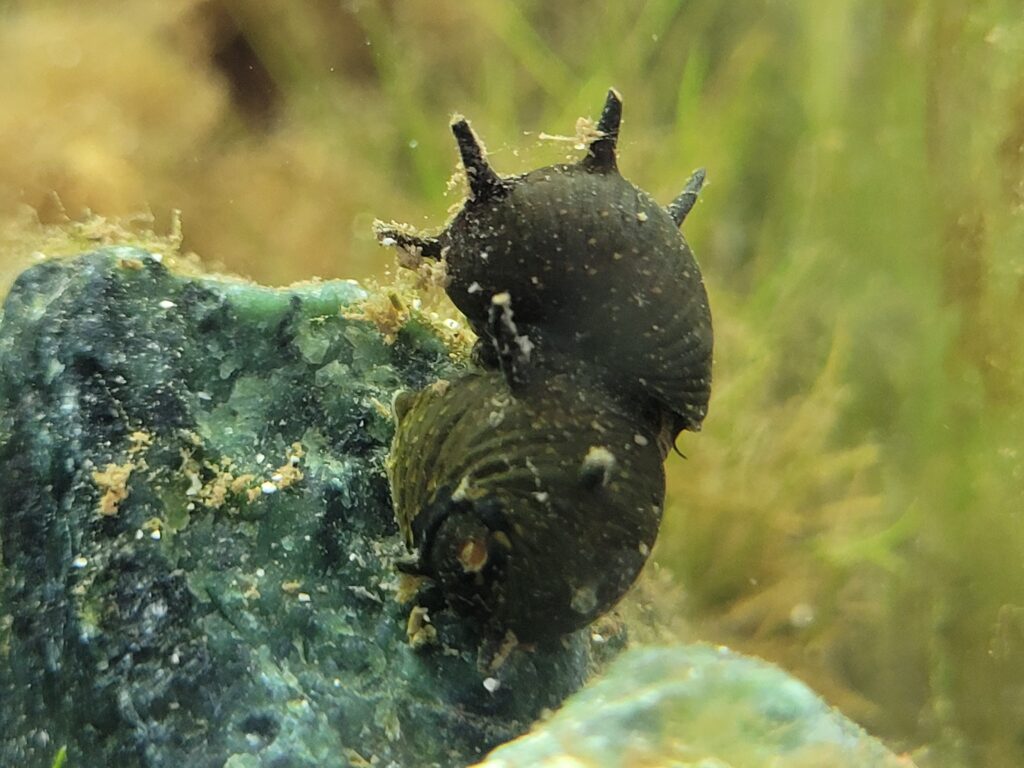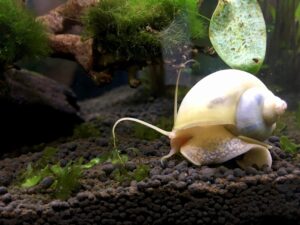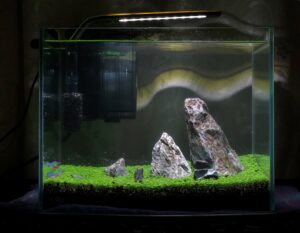
13 Different Types of Nerite Snails You Should Have

Writer at The Aquarium Keeper
Aquatic snails are a big part of the fishkeeping hobby. Snails are excellent at eating algae and cleaning the tank, and one of the most popular aquatic invertebrates is the nerite snail. There are a lot of different types of nerite snails, which have their own unique shells. In this article, I will introduce a bunch of different types of nerite snails, that you should consider owning.
Nerite Snail Species Overview
To begin, it is important to explain the basic needs of these species. A bunch of nerite snails on this list come from different parts of the world, but all of them enjoy similar water parameters. Nerite snails are relatively hardy creatures and can tolerate a wide range of different water parameters. They also like in brackish waters, but do perfectly in freshwater too. Here are the preferred things you should know about nerite snails:
- Water Temperature: 20–26 °C (60–79 °F)
- pH: 6.0–8
- Water Hardness: 6-12dH
- Minimum Tank Size: 5 gallons
- Diet: Mainly herbivorous (eating all sorts of algae, dying plant leaves), can sometimes also eat leftover fish food, or even deceased tank mates
- Tank Setup: Aquarium needs a filter, heater, and lighting installed. Even though snails are small, they still produce waste.
- Temperament: Very peaceful
- Tank Mates: Nerite snails can live with any other species, that are peaceful, that includes neocaridina shrimp, neon tetras, betta fish, galaxy rasboras, guppies, platies
- Decorations: Decorations really don’t matter for snails, since they hide in their shell, but driftwood, rocks, and plants would make your tank look better
- Lifespan: 1-2 years
- Breeding: Nerite snails can only breed in brackish water conditions since their eggs can’t hatch in freshwater. Nerite snails will lay eggs in freshwater aquariums, but they will stay unhatched
- Size: up to 1.5 inches (4 cm), depending on the species
- Dangers: Nerite snails are extremely sensitive to copper, so make sure to test your tap water before using it for aquariums
- Care Level: Easy
Nerite snails are considered to be one of the best algae eaters in the aquarium hobby, so many people include them in their tanks for maintenance purposes. Other than that, nerites are extremely peaceful, and really don’t bother anyone, since they live their own life. Of course, this is very basic information about nerite snails, and if you are looking for a nerite snail care guide, there are a lot of them on the internet.
Types of Nerite Snails
To begin this nerite snail list, it is important to mention, that some nerite snails are very common in this hobby, and can be found in most aquatic stores. Other rare species are not yet widely available, and the price of these nerite snails is only preliminary. The coloration of nerite snail shells can also be different from the pictures you see in this article.
Zebra Nerite Snail
This list starts with the most common snail in the aquarium hobby – the zebra nerite snail. You probably have seen these types of nerite snails in your local aquarium shop, because they are widely popular almost everywhere.

Zebra nerite snails have a very appealing shell, that is easily recognizable. These species have a distinctive black and gold stripe shell, that really resembles the pattern of a zebra, hence the name. Here is more information about zebra nerite snail:
- Scientific Name: Neritina Natalensis
- Origin: Northeastern, Southern Africa
- Rarity: Very common
- Price: 2-4$ per snail
Zebra nerites are probably the most common nerites in this hobby. If the water conditions are right, these snails can sometimes even live longer than the normal expectancy of a nerite snail. These species are not that impressive in terms of looks, compared to other nerite snail variants, since zebra nerites almost always look the exact same.
You might also like to read: 16 Types of Aquarium Snails You Should Have
Horned Nerite Snail
Another cool and fairly common types of nerites snails are the horned nerites. Most people are amazed by the looks of these species, since every snail always looks different, unlike zebra nerite snails.

Horned nerite snails have a very unique shell, that can have a lot of small horns on it. Thorns can be seen as a defensive measure from predators and other aquatic creatures. There are a lot of different colors of horned nerite snails: some can be found in black color, other horned nerite snails are yellow, and some can even have a zebra-type pattern on their shell. Here is more information about horned nerite snails:
- Scientific Name: Clithon Corona
- Origin: Southeast and East Asia
- Rarity: Common
- Price: 3-5$ per snail
Although every horned nerite snail is different, these species are fairly common. In most cases, you can easily find the basic horned nerites in every aquatic store, and the ones with the most unique shells can sometimes be more expensive.
Sun Thorn Nerite Snail
Moving on, sun thorn nerite snails are very similar to horned nerites in terms of appearance, but they have their distinctive features.

These species are slightly rare than horned nerites, and look different. Sun thorn nerites either have or don’t have horns, and also have a shell, that can have yellow, black, or even white coloration. Here is more information about this type of snail:
- Scientific name: Clithon Donovani
- Origin: Indo-Pacific region
- Rarity: Rare
- Price: 4-6$ per snail
Some sun thorn snails even have a wrinkle pattern on their shell, which makes them more detailed and pretty. These species are way rarer than others previously mentioned and are not that widely available.
You might also like to read: Freshwater Snail Eggs in Fish Tank: What To Do?
Olive Nerite Snail
Moving on, the next type of nerite snail on this list is the olive nerite snail. It is also known as a tiger eye nerite snail because the shell of this type of nerite can sometimes resemble an eye of a tiger.

Olive nerite snails are less colorful than other more interesting types of nerite snails. Mostly olive nerites come in brown or yellowish color and can have small black stripes on its shell. Here is more information about olive nerite snails:
- Scientific name: Neritina Reclivata
- Origin: North, South, and Central America
- Rarity: Rare
- Price: 3-5$ per snail
These species are the closest to zebra nerite snails in appearance. Some people could even argue, that they look almost the same, but olive nerite snails just have smaller black stripes than zebra nerite snails.
Tiger Nerite Snail
Another widely available snail is the tiger nerite snail. These species are very unique in terms of appearance, and can even be found in multiple colors across different pet stores.

Tiger nerite snails have different size black dots, which usually create a big thick line across their shell. These species can also have red, brown, or even yellow coloration on their shell. Here is more information about tiger nerite snails:
- Scientific name: Neritina Semiconica
- Origin: India
- Rarity: Rare
- Price: 3-5$ per snail
Red Racer Nerite Snail
Red racer nerite snails are probably one of the most beautiful types of nerite snails in the aquarium hobby. The shell on these snails can even look not real, and somebody made it from scratch.

Every red racer snail has a unique pattern on their shell. Some have stripes, dots, and even arrows. The coloration of these species is also very different, some snails mainly have red color dominating their shell, while others have just a little bit of red. Here is more information about red racer nerite snails:
- Scientific name: Vittina Waigiensis
- Origin: Philipines
- Rarity: Very rare
- Price: 7-10$ per snail
Red racer nerite snails are probably the most expensive snails on this list, and the least available. The simple reason is their appearance. These snails have unique shells, and every aquarium keeper wants them.

Selectively bred Red Nerite Racer Snails for purchase in the United States. Live arrival guaranteed!

Gold Racer Nerite Snail
Moving on, gold racer nerite snails are the exact same species as red racer nerites, but I still decided to include them on this list, because of their unique appearance.

These species have a very distinctive appearance and can have stripes, dots, and all other sorts of weird lines on their shell. Every gold racer snail is different, but the main colors of gold racer nerite snail shells are yellow and brown. Here is more information about these species:
- Scientific name: Vittina Waigiensis
- Origin: Philipines
- Rarity: Very rare
- Price: 5-7$ per snail
Similar to red racer nerites, gold racer nerite snails are also extremely rare, because of their looks. The price of these species is also higher because there are not many of them available.
Batik Nerite Snail
Moving on, the batik nerite snail is another cool addition to this list. The word “batik” is an Indonesian cloth dyeing tactic, and this snail is very similar in appearance to that dyeing pattern.

Batik nerite snails are also similar to zebra nerites, but these species have yellow dots on their shell, instead of stripes. Similar to zebra snails, most batik nerites look the same. Here is more information about these species:
- Scientific name: Neritina Variegata
- Origin: Indonesia
- Rarity: Rare
- Price: 5-7$ per snail
Even though batik snails are not that exciting in terms of looks, these snails are quite rare and are not available in most places. Some batik nerite snails can have very small yellow dots, making them almost black, while others have very huge yellow dots.
King Koopa Nerite Snail
One of the most bizarre-looking types of nerite snails is the king koopa nerite. The shell and the appearance of this snail are far different from all the other ones on this list. The word “king koopa” is a reference to the character “Bowser” from a video game called “Mario”. That character has a shell on its back, which is similar to this snail.

- Scientific name: Neritina Juttingae
- Origin: Indonesia
- Rarity: Very rare
- Price: 5-7$ per snail
Lightning Bolt Nerite Snail
Another cool-looking snail is the lightning bolt nerite snail. These species are very similar to zebra snails, but they have a little different coloration pattern on their shell.

These species are known for their gold and black coloration, and the unique lightning pattern on their shell. Unlike zebra nerites, these species portray different patterns on every shell, which makes them more unique. Here is more information about lightning bolt nerite snails:
- Scientific name: Neritodryas Dubia
- Origin: Philippines
- Rarity: Rare
- Price: 5-7$ per snail
It can also be very easy to confuse zebra nerite with lightning bolt nerite snails. These species are not as widely available as zebra nerites, but can sometimes look almost identical.

Selectively bred Lightning Bolt Nerite Snails for purchase in the United States. Live arrival guaranteed!

Red-Mouth Nerite Snail
One of the less popular types of nerite snails on this list is the red-mouth nerite snail. They are not widely available in this hobby, and there is not a lot of information about these species on the internet.

In terms of appearance, the red-mouth nerite snail can have a dark violet or dark red shell, and can even sometimes contain multiple colors. Here is more information about these species:
- Scientific name: Neritina Violacea
- Origin: Asia
- Rarity: Very Rare
- Price: 7-15$ per snail
Another cool factor about red-mouth nerites is their body color. Some red-mouth nerite snails have red bodies, so when they appear on the glass, it looks like a big red blob is slowly moving across your aquarium. It is different because traditionally nerites have a dark body color.
Midnight Black Nerite Snail
Moving on, a snail, that would look amazing on a white substrate is the midnight black nerite snail. These species are very straightforward and simple in terms of coloration.

As the name suggests, midnight black snails have a shell that is dominated by the black color and can sometimes have small yellow spots in some places. Here is more information about midnight black snails:
- Scientific name: Vittina Jovis
- Origin: Philippines
- Rarity: Rare
- Price: 3-7$ per snail
One unique thing about these species is that even the snail’s body can have different coloration than usual. Midnight black nerite snails can sometimes have yellow or orange coloration on their body, which makes them even more attractive.
Batman Nerite Snail
The last snail on this list is the batman nerite snail. This snail is just different from any other nerites, in terms of shell shape and appearance.

Batman nerite snail has a unique shell shape, that is round in some parts, and in others straight. The shell also has dark coloration and can have some brown or yellow dots too. Here is more information about these species:
- Scientific name: Neritina Auriculata
- Origin: Indonesia
- Rarity: Very Rare
- Price: 5-15$
Because these snails are very rare and are not that widely available in this hobby, the price is slightly higher than usual. The unique appearance of this snail also makes it easily recognizable, so if you see one in the store, be sure to buy it, before somebody else does.
Frequently Asked Questions
Can Different Nerite Snail Species Crossbreed?
There is really no scientific study, that could agree or disagree with this question, although according to practice, nerite snails usually don’t crossbreed. You can only breed nerite snails with the same species.
Do Nerite Snails Eat Fish Poop?
Nerite snails don’t eat fish poop, because it does not have any valuable nutrients in it. Nerite snails mainly eat algae, and fish poop is not a reliable food source for them.
Writer's Thoughts
In my opinion, nerites are very cool aquatic creatures, and I was amazed by how many different types of nerite species there are in the hobby. Some are more colorful, others have unique shell shapes.
If you enjoyed reading my article about different types of nerite snails, please feel free to share it with your friends by clicking the social media buttons below:

Thank you for reading my blog post. This website was created with the sole intention of providing quality information regarding fishkeeping. I have been in the fishkeeping hobby for 8 years, and through many trials and errors as well as online research I gathered a lot of information, which I want to give back to the community.





